This video is sponsored by Foreo.
As you get older, your skin changes and you’ll need to adapt your routine. Here are some tips and tricks on what you might want to add or subtract as your skin matures.
The video is here, the written version continues below…
Tip: Not everything can be fixed with skincare products
I think microcurrent really highlights an important concept for deciding what to use: working out exactly what you’re trying to address.
When you get older, a lot of the changes in your face don’t have anything to do with skin. For example, the larger changes – sagging, drooping, volume loss, changing face shape – are to do with muscle, bone and fat, which are under the skin. These are too deep for skincare products to effectively reach.
To change these, you generally need things like fillers, surgery, facelifts, botox, and so on. Trying to change this with skincare just isn’t going to work very well. Skincare that claims to reduce sagging and drooping can help a little bit, but since skin is only two millimeters thick, the effects are going to be limited.
I think a lot of people are pretty uncomfortable with these more invasive procedures – I am a complete wuss when it comes to this sort of thing! One of the few at-home treatments that can go deeper than skin is microcurrent – I reviewed the Foreo Bear earlier.
Related post: Microcurrent Devices: Science and Foreo Bear Review
Microcurrent can make your face look more lifted, by altering how your muscles tense up, and it can give you the appearance of more volume. It doesn’t seem to have much effect on fat and bone, but it does seem to increase muscle size, which can compensate for other reductions in volume.
You can generally see the effects pretty immediately. The most obvious changes are usually with more lifted and sculpted cheeks, and forehead lifting. In general, the effect is going to be more dramatic if your face is starting to droop a bit – if you’re in your late teens or early 20s, the effect is probably going to be very limited ,but from your mid to late 20s onwards, you can start to really see that effect.
Each treatment is only two to three minutes a day, and the effect lasts for a few days. So you do have to keep on using it to maintain the look, and the effect builds up the more you use it.
I’ve seen some people say that because it has a temporary and subtle effect, it’s not worth it. I disagree. I think that perspective mostly comes from people who don’t wear makeup – with makeup, subtle and temporary changes in your appearance can make a big difference. Microcurrent is less temporary than makeup, and it can have a more dramatic effect that you can’t really get easily with makeup (unless you’re super talented).
One important note about microcurrent is that you need to be consistent for it to work, and I really like the Foreo Bear’s design for that. It’s very easy to charge (via a USB cable, with no bulky charging cradle) and has a silicone body which makes it really easy to wipe down, and keep clean and hygienic.
Intrinsic vs Extrinsic Changes
The changes that happen to your skin as you get older can be split into two categories: intrinsic and extrinsic.
Intrinsic changes happen because your body functions differently as it gets older, and your skin is part of your body. These changes are largely unavoidable the main changes we see in skin is that it gets thinner and more fragile and you’ll start to see fine wrinkles extrinsic changes happen because of the environment the older you are the longer you’ve been exposed to the environment
Tip: The biggest cause of extrinsic skin changes is the sun
The main damaging extrinsic factor that affects your skin is the sun. You’re probably sick of hearing it, but this is why everyone keeps on saying to wear sunscreen! The most common changes we see in skin exposed to a lot of sun are deep wrinkles and crevices, age spots, scaling and dryness.
In caucasian skin, about 80% of the signs of aging that you see are because of sun exposure. With darker skin there’s melanin, which is protective against UV light, but we still see lots of changes – the main changes are related to pigment (e.g. age spots).
Unsurprisingly, the best way to prevent these changes is sun protection. The obvious one is sunscreen. A sunscreen that has high UVA and UVB protection is a good idea – both of these contribute to skin damage, so you’re looking for a broad spectrum, high SPF sunscreen that you can happily wear every day.
One study found that daily sunscreen use actually reversed the signs of photoaging. I think this goes to show that your skin is living, and has the ability to start repairing itself – as long as you protect it from getting reattacked every day.
Tip: You may need sunscreen indoors
In general, it’s a good idea to wear sunscreen on your face every day when you go outside, if you want to slow down these extrinsic changes in your skin. When you’re indoors, there’s obviously less UV.
UVB doesn’t penetrate glass, but depending on your situation, you can still get a large amount of UVA. If you’re close to a sunny window every day, then it’s still a good idea to wear sunscreen indoors.
Related post: Should You Wear Sunscreen Indoors? The Science (with video)
When you’re in a car, I guess you’re technically indoors, but there are windows everywhere! So it’s one of the highest levels of UV exposure you get while technically indoors. There’s this really famous photo of a truck driver, and you can really see the difference when you’re really close to a window and receiving direct UVA exposure.
I’ve had some people ask me about fluorescent lights. Fluorescent lights can produce tiny amounts of UV. In particular, windy compact fluorescent bulbs produce more UV, because the curves mean that the UV-absorbing coating inside the bulb gets cracked more easily. But it’s still a really tiny amount of UV.
If you’re more than 25 cm (about a foot) away from the light, it takes about 8 hours to get the equivalent of just over a minute of midday sun exposure in Sydney or Melbourne. If you have a plastic diffuser over the top (like you would in a normal office fluorescent light), then you get even less UV. So for the vast majority of us, that amount of UV isn’t worth worrying about. If you have a photosensitizing condition, like some types of lupus, then it could be significant (talk to your doctor).
Tip: Sunscreen sticks can stay on better around the eyes
We tend to get a lot of wrinkles near our eyes first, but unfortunately sunscreen near your eyes can really sting. I’ve been adding eye sting into my sunscreen reviews, but I’ve found that some sunscreens that don’t sting my eyes will sting other people’s eyes, and vice versa. In general alcohol and chemical sunscreens tend to sting people’s eyes a bit more.
I’ve found mineral sunscreen sticks really helpful. Sticks tend to run a lot less – they have a lot more waxes in them, so they’re a lot more water resistant. This can really help if you want to get sunscreen around your eyes, but you don’t want to risk it running in.
Tip: Use sunscreens that don’t work for your face on your neck and hands
It’s important to remember that it isn’t just your face that gets a lot of sun exposure. It’s also your neck and your hands. If you have a sunscreen that doesn’t really work for your face, you can still use it up there!
Tip: UV protective hats and clothing are great
Sun protection isn’t just about sunscreen. There are other things you can do as well, like avoiding direct sun exposure for too long in the middle of the day, when there’s the most UV.
You can also use UV protective clothing like hats and gloves. I keep a UV protective cardigan in the car. It was originally because I forget to take it with me a lot of the time, but I’ve also been slipping my arm into the sleeves backwards when I’m driving to protect my arms and the backs of my hands.
Related posts: How to Choose UV Protective Clothing
Tip: Introduce retinoids slower than you think you should
Even if you hide from the sun, there are still intrinsic changes. Even without sun exposure, your epidermis will thin by up to half between the ages of 30 and 80.
There are lots of other things you can use in skincare. Retinoids are always what dermatologists recommend. Tretinoin (also known as retinoic acid or Retin-A) is the gold standard ingredient, and there’s tons of research to back up its effectiveness. It can reduce fine and coarse wrinkles, roughness, freckles and pigmentation. It can actually make changes to the lower layers of your skin, increasing the growth of fibroblast cells in your dermis, and increasing collagen.
Tretinoin is a pharmaceutical, and usually prescription-only, so if you think that might be suitable for you, talk to a doctor. There are also weaker versions in cosmetics like retinol and Granactive Retinoid, which tend to have less side effects.
If you’re introducing a retinoid into your routine, be really careful – go slower than you think you have to! If you use too much too quickly, you can have lots of side effects like dryness, redness, irritation and stinging.
Related post: My Routine for Starting on Tretinoin (Retin-A) Cream (with video)
Tip: Skin gets more fragile as you get older
As your skin gets older, it doesn’t hold on to water as well, so it tends to get thinner and dry out more easily. It also becomes more fragile, becoming less resilient to trauma and healing slower. So you’ll have to treat your skin a bit more gently – things like harsh physical exfoliants and rough washcloths probably won’t be as suitable.
You’ll probably want to use less hot water in your routine as well, since hot water is really good at washing away the natural moisturisers that your skin produces.
Tip: Hydrated skin exfoliates itself better
As your skin ages, you may find that you need to use more moisturiser. I think a lot of us think of moisturiser as inactive, but keeping your skin hydrated is important in allowing it to function correctly.
One of the changes in your skin as you get older is that your skin doesn’t exfoliate itself (desquamate) as effectively. Part of this is that your skin turnover decreases (you’re not producing skin cells as quickly), but part of it is just dehydration. When your skin is dehydrated, it doesn’t exfoliate itself correctly, so hydrating it can help.
Tip: Wear sunscreen when using AHAs
If your skin still isn’t exfoliating itself enough despite adequate hydration, you might want to add in a chemical exfoliant. Alpha hydroxy acids are the chemical exfoliators with the best evidence for them for anti-aging, and they work by they speed up the skin turnover that slows down as you get older. They also help with other things as well, such as evening out pigmentation, decreasing roughness and increasing collagen.
There are different strengths with AHA treatments. A leave-on chemical exfoliant won’t get as deep as a professional peel, for example.
One of the issues with alpha hydroxy acids is that it can increase UV sensitivity – make sure you’re also using a sunscreen.
Tip: Clinical studies on the final formula are a good sign
There are some other anti-aging ingredients that can be effective as well, in particular, antioxidants, vitamin C and peptides. There is less evidence for these, but they could be worth looking into depending on your situation.
There’s a lot of variability when it comes to the formulas of these though, so a good rule of thumb is to look for clinical tests on the finished formula (e.g. before and after photos and clinical studies).
Tip: Deeper pigment is usually difficult to treat with skincare products
If you’re looking to fade hyperpigmentation, one important thing to consider is the depth of the pigment.
Most skin care (especially if you’re not using drug products) can only effectively reach surface-level pigment. Some good ingredients for dealing with pigment are retinoids, hydroquinone, vitamin C, arbutin, kojic acid, niacinamide and licorice extract.
Be careful with extracts though – there are lots of different types of extracts, and not all licorice extracts will actually help with pigment. Make sure you look for a product that actually specifies that it addresses pigment issues.
If you have deeper pigment that these skincare products aren’t really affecting, or if you’re not sure how deep your pigment is, go to a professional who can diagnose your problem and potentially use stronger treatments like lasers and peels.
Tip: Sleeping on your back can reduce sleep wrinkles
Wrinkles come from repeated movements as well as the condition of your skin. You can think of it like a piece of leather – wrinkles will form when you fold that leather repeatedly. This is why you might have heard of preventative botox that actually stops your face from moving as much, so you don’t add to these folded-in wrinkles.
There are also wrinkles called sleep wrinkles that come from sleeping on your side or front. Your face basically gets smushed up, and because we sleep for about a third of our lives, this smooshing can etch in wrinkles. For a lot of people, it can be worth it to train yourself to sleep on your back.
Some people shouldn’t be doing this though, because there might be other reasons they’re not sleeping on their back like sleep apnea, and this is way more serious than sleep wrinkles. For some people, sleeping on their backs just decreases the quality of sleep so much that it’s not worth it.
For people who want to try sleeping on their back, a special pillow like those from Sleep and Glow can make it a bit more convenient although they’re not necessary. You can use wedge pillows or you can use towels to try to keep your head in one spot, and you can also try to use a heavier quilt that holds you in place.
Tip: Use primer and apply less product to limit concealer creasing
I’m still working on trying to get my concealer to sit properly on my oily skin, but Angie from Hot and Flashy has tons of great tips! Using a primer underneath the concealer can really help spread it out evenly and keep it from shifting into lines. Although a bit counter-intuitive, using less concealer can actually help as well, since there’ll be less stuff that can move.
With products like highlighters, it’s good to avoid large particles because they tend to settle into lines and make them more obvious.
Do you have any other tips for adapting your routine?
This post is sponsored by Foreo; however, the content is all based on my independent research and my honest experience. For more information, see Disclosure Policy.
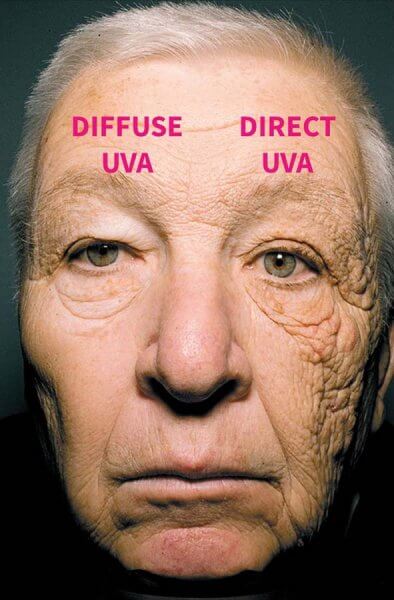


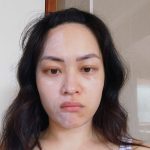
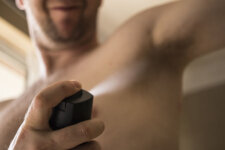
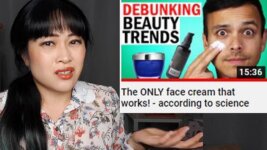
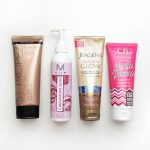
Oh yes, introduce retinoids slower than you think – one of the main lessons I had to learn myself!
Hi Michelle!
Here in Europe many anti-age products you have been talking dont exist, I’m trying to read the ingredients to choose what might work for my dry sensitive skin. Have you heard about the uriage age protect cream? It has vitamin C and E and retinol and some UV protectiong, can I know your opinion on it by the ingredients list? Thank you!